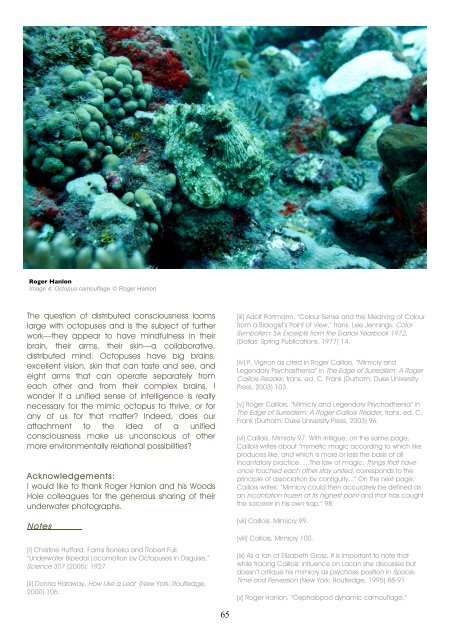Animal Influence I - Antennae The Journal of Nature in Visual Culture
Animal Influence I - Antennae The Journal of Nature in Visual Culture
Animal Influence I - Antennae The Journal of Nature in Visual Culture
You also want an ePaper? Increase the reach of your titles
YUMPU automatically turns print PDFs into web optimized ePapers that Google loves.
Roger Hanlon<br />
Image 4: Octopus camouflage Roger Hanlon<br />
<strong>The</strong> question <strong>of</strong> distributed consciousness looms<br />
large with octopuses and is the subject <strong>of</strong> further<br />
work—they appear to have m<strong>in</strong>dfulness <strong>in</strong> their<br />
bra<strong>in</strong>, their arms, their sk<strong>in</strong>—a collaborative,<br />
distributed m<strong>in</strong>d. Octopuses have big bra<strong>in</strong>s,<br />
excellent vision, sk<strong>in</strong> that can taste and see, and<br />
eight arms that can operate separately from<br />
each other and from their complex bra<strong>in</strong>s. I<br />
wonder if a unified sense <strong>of</strong> <strong>in</strong>telligence is really<br />
necessary for the mimic octopus to thrive, or for<br />
any <strong>of</strong> us for that matter? Indeed, does our<br />
attachment to the idea <strong>of</strong> a unified<br />
consciousness make us unconscious <strong>of</strong> other<br />
more environmentally relational possibilities?<br />
Acknowledgements:<br />
I would like to thank Roger Hanlon and his Woods<br />
Hole colleagues for the generous shar<strong>in</strong>g <strong>of</strong> their<br />
underwater photographs.<br />
Notes<br />
[i] Christ<strong>in</strong>e Huffard, Farnis Boneka and Robert Full,<br />
“Underwater Bipedal Locomotion by Octopuses <strong>in</strong> Disguise,”<br />
Science 307 (2005): 1927.<br />
[ii] Donna Haraway, How Like a Leaf (New York: Routledge,<br />
2000) 106.<br />
65<br />
[iii] Adolf Portmann, “Colour Sense and the Mean<strong>in</strong>g <strong>of</strong> Colour<br />
from a Biologist’s Po<strong>in</strong>t <strong>of</strong> View,” trans. Lee Jenn<strong>in</strong>gs. Color<br />
Symbolism: Six Excerpts from the Eranos Yearbook 1972,<br />
(Dallas: Spr<strong>in</strong>g Publications, 1977) 14.<br />
[iv] P. Vignon as cited <strong>in</strong> Roger Caillois, “Mimicry and<br />
Legendary Psychasthenia” <strong>in</strong> <strong>The</strong> Edge <strong>of</strong> Surrealism: A Roger<br />
Caillois Reader, trans. ed. C. Frank (Durham: Duke University<br />
Press, 2003) 103.<br />
[v] Roger Caillois, “Mimicry and Legendary Psychasthenia” <strong>in</strong><br />
<strong>The</strong> Edge <strong>of</strong> Surrealism: A Roger Caillois Reader, trans. ed. C.<br />
Frank (Durham: Duke University Press, 2003) 96.<br />
[vi] Caillois, Mimicry 97. With <strong>in</strong>trigue, on the same page,<br />
Caillois writes about “mimetic magic accord<strong>in</strong>g to which like<br />
produces like, and which is more or less the basis <strong>of</strong> all<br />
<strong>in</strong>cantatory practice. …<strong>The</strong> law <strong>of</strong> magic, Th<strong>in</strong>gs that have<br />
once touched each other stay united, corresponds to the<br />
pr<strong>in</strong>ciple <strong>of</strong> association by contiguity...” On the next page,<br />
Caillois writes: “Mimicry could then accurately be def<strong>in</strong>ed as<br />
an <strong>in</strong>cantation frozen at its highest po<strong>in</strong>t and that has caught<br />
the sorcerer <strong>in</strong> his own trap.” 98<br />
[vii] Caillois, Mimicry 99.<br />
[viii] Caillois, Mimicry 100.<br />
[ix] As a fan <strong>of</strong> Elizabeth Grosz, it is important to note that<br />
while trac<strong>in</strong>g Caillois’ <strong>in</strong>fluence on Lacan she discusses but<br />
doesn’t critique his mimicry as psychosis position <strong>in</strong> Space,<br />
Time and Perversion (New York: Routledge, 1995) 88-91<br />
[x] Roger Hanlon, “Cephalopod dynamic camouflage,”












